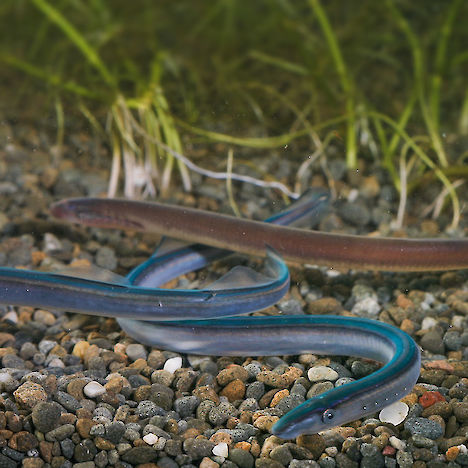Other names:
Kanakana, pihapiharauThreat category:
Threatened: Nationally Vulnerable?Regions:
Northland, Auckland, Waikato, Bay of Plenty, Gisborne, Hawkes Bay, Manawatu-Wanganui, Taranaki, Wellington, Nelson-Tasman, Marlborough, Westcoast, Canterbury, Otago, SouthlandDistribution:
Throughout New Zealand, at low to mid altitudes.
Description
- Lamprey are superficially eel-like, but lack jaws, have a round sucker-like mouth, seven pairs of external gill openings and no paired fins near the head.
- The lack of paired fins give them a more snake-like swimming pattern in the water, with the head moving from side to side (eels have paired fins and so their head stays more central).
- Lamprey juveniles are a muddy grey-brown in colour and this changes to a bright silvery-blue when they migrate out to sea.
- Adults colouration changes from the bright silvery-blue to a more dull brown-grey with two long thin turquoise stripes along their back, as they spend more time in freshwater.
- Male adults develop a large baggy pouch below their head.
Interesting Facts
- As juveniles they have no eyes and feed by filtering micro-organisms from the water.
- After 4-5 years in freshwater they migrate to the sea.
- They spend 3-4 years at sea, and use their sucker mouth to attach themselves to other animals and feed on their flesh.
- Adults spawn in freshwater and migrate upstream in winter and spring; when in freshwater they do not feed.
- They are widespread and can be found long distances inland (almost as far from the sea as possible).
- Lamprey have great cultural significance.
- River species require good riparian cover, streamside shade and logs and/or boulders instream.
Association with Plantations
- All indigenous fish species can occur in, or move through, plantation forestry areas.
- Plantation streams and lakes often have relatively high populations.
Threats
- Destruction of riparian vegetation.
- Competition and predation from introduced fish species.
- Fishing pressure.
- Habitat destruction from:
- Modification of riparian margins.
- Introduction of aquatic weeds.
- Siltation.
- Eutrophication (high nutrients).
- Erosion of banks through grazing by livestock, goats and deer.
Management Options and Methods
- Maintain corridors of riparian vegetation along banks. Corridors should be as extensive as possible (refer to Buxton 1991).
- If possible, expand width of riparian zones during later rotation planting.
- Exclude livestock from riparian areas.
- Control deer and goats that could enter riparian areas.
- Comply with best forest operational management practices to avoid damage to riparian areas.
- Provide adequate fish passage through any artificial barriers within streams, e.g. building up downstream side of culverts with Gabion baskets of boulders or using other designs (refer Buxton 1991, Jowett 1999).
- Manage or prevent water abstraction from critical habitat areas.
- Regulate or prevent fishing of threatened species.
- Prevent introductions of exotic fish.
- Prevent introductions of aquatic weeds. Educate local users of weed threats and how to prevent spread.
Monitoring Options
- Undertake surveys to identify fisheries values and species.
- Consider repeating fish surveys every few years to ascertain whether key species are still present.
- Liaise with DOC about fish survey and monitoring methods.
- Report findings to DOC.
- Periodic checks of banks to ensure compliance with best forest operational management practices, pest and weed levels and siltation.
Further Information and Support
- DOC – advice for management, survey, and monitoring. Website http://www.doc.govt.nz/
- Buxton 1991. New Zealand’s wetlands: a management guide. Wellington, Department of Conservation.
- Jowett I. et al. 1999. Fish passage at culverts: a review with possible solutions for New Zealand indigenous species.
- McDowall R.M. 2000. The Reed Guide to Freshwater Fishes.
- NIWA website, Atlas of New Zealand freshwater fishes. Contains detailed identification guides and location maps. http://www.niwa.cri.nz/rc/freshwater/fishatlas/freshwater/fishatlas


